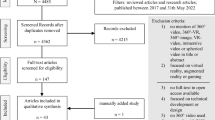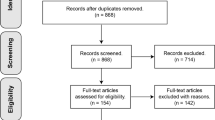Abstract
Although it is a relatively new innovation, 360 videos have gained commercial and public popularity. Given their novelty, there is a relative dearth of studies on their effectiveness. Most of the existing research is published as technical articles dealing with standards and specifications, as theoretical pieces promoting the potential value, or as descriptive experiences and resulting factors. Such work is arguably needed, but the field lacks deep research basis for justifying and clarifying the implementation of 360 video into practice. This article reports on a study exploring 360 videos for improving elementary mathematics teacher education. The results of the empirical study show improved immersion, presence, and video evaluation from using 360 video. Additionally, participants who viewed the videos on virtual reality headsets demonstrated increased attention to mathematical strategies in the context of teaching, demonstrating the potential usefulness of 360 headsets for perceptual capacity and teacher noticing.




Similar content being viewed by others

References
Ardisara, A., & Fung, F. M. (2018). Integrating 360° videos in an undergraduate chemistry laboratory course. Journal of Chemical Education, 95, 1881–1884.
Ball, D. L., Thames, M. H., & Phelps, G. (2008). Content knowledge for teaching: What makes it special? Journal of Teacher Education, 59(5), 389–407.
Bao, Y., Wu, H., Ramli, A. A., Wang, B., & Liu, X. (2016, November). Viewing 360 degree videos: Motion prediction and bandwidth optimization. In 2016 IEEE 24th International Conference on Network Protocols (ICNP) (pp. 1-2). IEEE.
Barnhart, T., & van Es, E. (2015). Studying teacher noticing: Examining the relationship among pre-service science teachers' ability to attend, analyze and respond to student thinking. Teaching and Teacher Education, 45, 83–93.
Baumert, J., Kunter, M., Blum, W., Brunner, M., Voss, T., Jordan, A., et al. (2010). Teachers’ mathematical knowledge, cognitive activation in the classroom, and student progress. American Educational Research Journal, 47(1), 133–180.
Boerst, T., Sleep, L., Ball, D. L., & Bass, H. (2011). Preparing teachers to lead mathematics discussions. Teachers College Record, 113(12), 2844–2877.
Borko, H., Roberts, S. A., & Shavelson, R. (2008). Teachers’ decision making: From Alan J. bishop to today. In P. Clarkson & N. Presmeg (Eds.), Critical issues in mathematics education (pp. 37–70). New York: Springer.
Brunvand, S., & Fishman, B. (2007). Investigating the impact of the availability of scaffolds on preservice teacher noticing and learning from video. Journal of Educational Technology Systems, 35(2), 151–174.
Calleja, G. (2011). In-game: From immersion to incorporation. Cambridge, MA: The MIT Press.
Cengiz, N., Kline, K., & Grant, T. J. (2011). Extending students’ mathematical thinking during whole-group discussions. Journal of Mathematics Teacher Education, 14, 355–374.
Chieu, V. M., Aaron, W. R., & Herbst, P. (2018). How can designed reference points in an animated classroom story support teachers’ study of practice? In R. Zazkis & P. Herbst (Eds.), Scripting approaches in mathematics education (pp. 147–162). Cham: Springer.
Choi, K., Yoon, Y. J., Song, O. Y., & Choi, S. M. (2018). Interactive and immersive learning using 360° virtual reality contents on Mobile platforms. Mobile Information Systems, 2018.
Christ, T., Arya, P., & Chiu, M. M. (2017). Video use in teacher education: An international survey of practices. Teaching and Teacher Education, 63, 22–35.
Corbillon, X., Simon, G., Devlic, A., & Chakareski, J. (2017, May). Viewport-adaptive navigable 360-degree video delivery. In 2017 IEEE international conference on communications (ICC) (pp. 1-7). IEEE.
Elmezeny, A., Edenhofer, N., & Wimmer, J. (2018). Immersive storytelling in 360-degree videos: An analysis of interplay between narrative and technical immersion. Journal For Virtual Worlds Research [online serial], 11(1), 13 manuscript pages.
Endsley, M. R. (2000). Theoretical underpinnings of situation awareness. In M. R. Endsley & D. J. Garland (Eds.), Situation awareness analysis and measurement (pp. 1–21). Mahwah, NJ: Erlbaum.
Estapa, A. T., Amador, J., Kosko, K. W., Weston, T., de Araujo, Z., & Aming-Attai, R. (2018). Preservice teachers’ articulated noticing through pedagogies of practice. Journal of Mathematics Teacher Education, 21(4), 387–415.
Ferdig, R.E. (2003). Review of the book breaking down the digital walls: Learning to teach in a post-modem world. Journal of Interactive Online Learning [Online serial], 2(1). Available from: http://www.ncolr.org/jiol/archives/2003/summer/5/index.asp. (PDF) (5 manuscript pages).
Gaudin, C., & Chaliès, S. (2015). Video viewing in teacher education and professional development: A literature review. Educational Research Review, 16, 41–67.
Geng, J., Jong, M. S. Y., Luk, E., & Jiang, Y. (2018, July). Comparative study on the pedagogical use of interactive spherical video-based virtual reality: The EduVenture-VR experience. In 2018 International Symposium on Educational Technology (ISET) (pp. 261-263). IEEE.
Grossman, P., Compton, C., Igra, D., Ronfeldt, M., Shahan, E., & Williamson, P. (2009). Teaching practice: A cross-professional perspective. Teachers College Record, 111(9), 2055–2100.
Harrington, C. M., Kavanagh, D. O., Ballester, G. W., Ballester, A. W., Dicker, P., Traynor, O., et al. (2018). 360° operative videos: A randomised cross-over study evaluating attentiveness and information retention. Journal of Surgical Education, 75(4), 993–1000.
Herbst, P., Aaron, W., & Erickson, A. (2013). How preservice teachers respond to representations of practice: A comparison of animations and video. Paper presented at the annual meeting of the American Educational Research Association. San Francisco: CA.
Herbst, P., Chazan, D., Chieu, V. M., Milewski, A., Kosko, K. W., & Aaron, W. R. (2016). Technology-mediated mathematics teacher development: Research on digital pedagogies of practice. In M. Niess, S. Driskell, & K. Hollebrands (Eds.), Handbook of Research on Transforming Mathematics Teacher Education in the Digital Age (pp. 78–106) IGI Global.
Hill, H. C., Ball, D. L., Blunk, M., Goffney, I. M., & Rowan, B. (2007). Validating the ecological assumption: The relationship of measure scores to classroom teaching and student learning. Measurement, 5(2–3), 107–118.
Hill, H. C., Blunk, M. L., Charalambous, C. Y., Lewis, J. M., Phelps, G. C., Sleep, L., & Ball, D. L. (2008). Mathematical knowledge for teaching and the mathematical quality of instruction: An exploratory study. Cognition and Instruction, 26(4), 430–511.
Izsák, A. (2008). Mathematical knowledge for teaching fraction multiplication. Cognition and Instruction, 26(1), 95–143.
Jacobs, V. R., Lamb, L. L., & Philipp, R. A. (2010). Professional noticing of children's mathematical thinking. Journal for Research in Mathematics Education, 169-202.
Jennett, C., Cox, A. L., Cairns, P., Dhoparee, S., Epps, A., Tijs, T., & Walton, A. (2008). Measuring and defining the experience of immersion in games. International Journal of Human-Computer Studies, 66(9), 641–661.
Kosko, K. W., Rougee, A., & Herbst, P. (2014). What actions do teachers envision when asked to facilitate mathematical argumentation in the classroom? Mathematics Education Research Journal, 26(3), 459–476.
Kunter, M., Klusmann, U., Baumert, J., Richter, D., Voss, T., & Hachfeld, A. (2013). Professional competence of teachers: Effects on instructional quality and student development. Journal of Educational Psychology, 105(3), 805–820.
Lampert, M., Franke, M. L., Kazemi, E., Ghousseini, H., Turrou, A. C., Beasley, H., et al. (2013). Kee** it complex: Using rehearsals to support novice teacher learning of ambitious teaching. Journal of Teacher Education, 64(3), 226–243.
Miller, K. (2011). Situation awareness in teaching: What educators can learn from videobased research in other fields? In M. G. Sherin, V. Jacobs, & R. Philipp (Eds.), Mathematics teacher noticing (pp. 51–65). New York: Routledge.
Reyna Zeballos, J. L. (2018, March). The potential of 360-degree videos for teaching, learning and research. In In The 12th annual International Technology. Education and Development: Conference.
Roche, L. & Gal-Petitfaux, N. (2017). Using 360° video in physical education teacher education. In P. Resta & S. smith (Eds.), Proceedings of Society for Information Technology & Teacher Education International Conference 2017 (pp. 3420-3425). Chesapeake, VA: Association for the Advancement of computing in education (AACE).
Scheiner, T. (2016). Teacher noticing: Enlightening or blinding? ZDM, 48(1–2), 227–238.
Shavelson, R. J., & Stern, P. (1981). Research on teachers’ pedagogical thoughts, judgments, decisions, and behavior. Review of Educational Research, 51(4), 455–498.
Shulman, L. S. (1987). Knowledge and teaching: Foundations of the new reform. Harvard Educational Review, 57(1), 1–21.
Siegel, S., & Castellan, N. J. (1988). Nonparametric statistics for the behavioral sciences (2nd ed.). New York: McGraw-Hill, Inc..
Simon, M. A. (1993). Prospective elementary teachers' knowledge of division. Journal for Research in Mathematics education, 233-254 .
Slingland, R. P. (1958). A study of the problems of installing and utilizing closed circuit television for observations and demonstrations in the teacher education program. Ellensburg, Washington: Central Washington State College Retrieved from https://digitalcommons.cwu.edu/etd/161.
Snelson, C., & Hsu, Y. C. (2019). Educational 360-degree videos in virtual reality: A sco** review of the emerging research. TechTrends, 1–9 https://doi.org/10.1007/s11528-019-00474-3.
Stahnke, R., Schueler, S., & Roesken-Winter, B. (2016). Teachers’ perception, interpretation, and decision-making: A systematic review of empirical mathematics education research. ZDM, 48(1–2), 1–27.
Stevens, A. L., Wilkins, J. L., Lovin, L. H., Siegfried, J., Norton, A., & Busi, R. (2018). Promoting sophisticated fraction constructs through instructional changes in a mathematics course for PreK-8 prospective teachers. Journal of Mathematics Teacher Education, 1-29.
Stockero, S. L., Rupnow, R. L., & Pascoe, A. E. (2017). Learning to notice important student mathematical thinking in complex classroom interactions. Teaching and Teacher Education, 63, 384–395.
Suh, A., & Prophet, J. (2018). The state of immersive technology research: A literature analysis. Computers in Human Behavior, 86, 77–90.
TaghaviNasrabadi, A., Mahzari, A., Beshay, J. D., & Prakash, R. (2017, March). Adaptive 360-degree video streaming using layered video coding. In 2017 IEEE Virtual Reality (VR) (pp. 347-348). IEEE.
Thanheiser, E., Browning, C., Edson, A. J., Lo, J. J., Whitacre, I., Olanoff, D., & Morton, C. (2014). Prospective elementary mathematics teacher content knowledge: What do we know, what do we not know, and where do we go? The Mathematics Enthusiast, 11(2), 433–448.
Van Es, E. A., & Sherin, M. G. (2002). Learning to notice: Scaffolding new teachers’ interpretations of classroom interactions. Journal of Technology and Teacher Education, 10(4), 571–596.
Wahbeh, N., & Abd-El-Khalick, F. (2014). Revisiting the translation of nature of science understandings into instructional practice: Teachers' nature of science pedagogical content knowledge. International Journal of Science Education, 36(3), 425–466.
Walshe, N., & Driver, P. (2019). Develo** reflective trainee teacher practice with 360-degree video. Teaching and Teacher Education, 78, 97–105 https://doi.org/10.1016/j.tate.2018.11.009.
Wereley, M., Broda, M., & Schmidt, A. (2018, March). Seeing is believing: Use of immersive technologies to facilitate deep engagement in experiential curricula. In Society for Information Technology & Teacher Education International Conference (pp. 1770-1775). Association for the Advancement of computing in education (AACE).
Windscheid, J., & Will, A. (2018). (2018). A web-based multi-screen 360-degree video player for pre-service teacher training. In Adjunct Proc. of the Intl.Conference on Interactive Experiences for TV and Online Video (TVX2018). ACM. Seoul.
Author information
Authors and Affiliations
Corresponding author
Ethics declarations
Disclosure of Potential Conflicts of Interest
The authors declare that they have no conflict of interest.
Ethical Approval
All procedures performed in studies involving human participants were in accordance with the ethical standards of the institutional and/or national research committee and with the 1964 Helsinki declaration and its later amendments or comparable ethical standards. This article does not contain any studies with animals performed by any of the authors.
Informed Consent
Informed consent was obtained from all participants included in the study.
Additional information
Publisher’s Note
Springer Nature remains neutral with regard to jurisdictional claims in published maps and institutional affiliations.
Rights and permissions
About this article
Cite this article
Ferdig, R.E., Kosko, K.W. Implementing 360 Video to Increase Immersion, Perceptual Capacity, and Teacher Noticing. TechTrends 64, 849–859 (2020). https://doi.org/10.1007/s11528-020-00522-3
Published:
Issue Date:
DOI: https://doi.org/10.1007/s11528-020-00522-3



